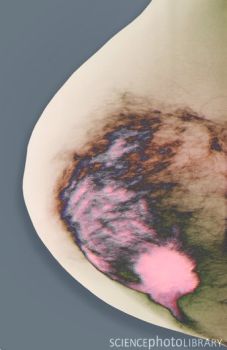 美国犹他州癌症研究中心的科学家们建立了一种新动物模型用于模拟人类乳腺癌疾病,利用它将可以有效预测乳腺癌扩散的可能性,也可以测试药物对抑制乳腺癌扩散的作用。
美国犹他州癌症研究中心的科学家们建立了一种新动物模型用于模拟人类乳腺癌疾病,利用它将可以有效预测乳腺癌扩散的可能性,也可以测试药物对抑制乳腺癌扩散的作用。
该研究的论文发表在最新一期的《Nature Medicine》杂志上。
为了建立有效的模型以进行乳腺癌研究,科学家们将乳腺癌患者的肿瘤组织移植入小鼠的乳腺中。他们发现和通常在实验室平板中培养癌细胞方法的结果不同,移植的肿瘤保持了原有乳腺癌组织的结构,且在遗传学和生长上也保持了原有特性。
研究的主要负责人,肿瘤科学部的助理教授Alana Welm博士说道:“最令人惊讶的是这些移植到老鼠体内的肿瘤从其最初的移植部位扩散了开来,就和患者体内一样。比如说,从那些癌细胞已扩散到肺部的患者体内取出的肿瘤组织,在小鼠体内也同样扩散到了肺部。”
大部分乳腺癌引起死亡的原因是由于癌细胞扩散到了身体的其它部位,比如淋巴系统、肺部、肝脏、骨髓和脑部。
另外,科学家们发现能够成功移植的乳腺癌组织几乎全部来自于那些乳腺癌细胞发生扩散的患者,并且这些患者都最终因其死亡。这些结果表明该模型可作为一种新的乳腺癌诊断方法,用来确认那些癌细胞是否有可能会发生扩散,以帮助临床医生选择合适有效的治疗方案。
Welm说道:“这类方法也许还可以用来开发其它种类癌症的模型,我们已经在开展关于结肠癌方面的研究了。”(生物探索译)
相关英文论文摘要:
Tumor grafts derived from women with breast cancer authentically reflect tumor pathology, growth, metastasis and disease outcomes
Development and preclinical testing of new cancer therapies is limited by the scarcity of in vivo models that authentically reproduce tumor growth and metastatic progression. We report new models for breast tumor growth and metastasis in the form of transplantable tumors derived directly from individuals undergoing treatment for breast cancer. These tumor grafts illustrate the diversity of human breast cancer and maintain essential features of the original tumors, including metastasis to specific sites. Co-engraftment of primary human mesenchymal stem cells maintains phenotypic stability of the grafts and increases tumor growth by promoting angiogenesis. We also report that tumor engraftment is a prognostic indicator of disease outcome for women with newly diagnosed breast cancer; orthotopic breast tumor grafting is a step toward individualized models for tumor growth, metastasis and prognosis. This bank of tumor grafts also serves as a publicly available resource for new models in which to study the biology of breast cancer.
英文论文链接:https://www.nature.com/nm/journal/vaop/ncurrent/full/nm.2454.html







